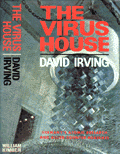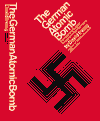
Saturday, March 5, 2005Hitler
won atomic bomb race, but couldn't drop
it By Ernest Gill in
Hamburg ADOLF Hitler had the
atom bomb first but it was too primitive
and ungainly for aerial deployment, says a
new book that indicates the race to split
the atom was much closer than is
believed. Nazi scientists carried out tests of
what would now be called a dirty nuclear
device in the waning days of World War II,
writes Rainer Karlsch, a German
historian, in his book Hitler's Bomb, to
be be published this month.  David
Irving
comments: David
Irving
comments:LET US marvel
once again at the ability of your
average broadsheet journalist to
write a story like this without
once consulting the author who
alone interviewed all the Nazi
atomic scientists and nuclear
physicists (and of course Reich
armaments minister Albert
Speer, without whom such a
project would have been
impossible) in writing his book
The
Virus
House
(The German Atomic Bomb, Simon
& Schuster, New York, 1967):
namely, myself.  By the time Prof Mark
Walker came along, these
scientists were dead, and he
relied heavily on my 1967 book
and documents while at the same
time lashing out at me as a --
guess what --
"Holocaust
denier". The biography of
Werner Heisenberg by
Thomas Powers is more
discerning.
That Walker can
be a professor at a New York
college and spout these views is
disturbing (unless he is doing so
for a fee). That a reputable firm
like Deutsche Verlags-Anstalt
published the book -- they are
after all Germany's
quasi-official history publishers
-- is equally astonishing. My
book was published in Germany,
and Der Spiegel serialised
it for several weeks. What were
these new folks all smoking, one
wonders?  NOW to the claims which this new
author makes: they are rubbish,
from the Rudolf-Hess-
wasn't-really- Rudolf Hess school
of history.
NOW to the claims which this new
author makes: they are rubbish,
from the Rudolf-Hess-
wasn't-really- Rudolf Hess school
of history.
Here is a brief
synopsis of the real German
atomic research story. There were
two rival teams working towards
getting an atomic pile critical
-- one of theoretical scientists
and academics under Nobel prize
winner Werner Heisenberg, the
other a more empirical team under
army scientist Dr Kurt
Diebner.
Both teams had
wrongly been informed by
mathematician Professor
Bothe that graphite could
not be used as a moderator in an
atomic pile (now called a nuclear
reactor); this left only "heavy
water" (deuterium oxide) as a
choice, and this substance
dribbled forth from the
much-attacked heavy water plant
in Norway at such a painfully
slow rate that they still did not
have enough when the war
ended.
Heisenberg's
men nevertheless began building a
rudimentary pile in a cave at
Haigerloch in southern Germany
(see my picture below),
with which they experimented
until they were captured by the
ALSOS
mission headed by US colonel
Boris Pash and his MI6
colleague Michael
Perrin.
Diebner's army
team did actually attempt to
create a fusion reaction by
imploding conventional explosives
on deuterium (heavy water), in
one rudimentary experiment.
The German war
economy lacked all the basic
resources to build an atomic
fission bomb, once Speer had
assigned top priority to the V2
rocket project. It had no means
whatever to build a "dirty"
bomb.
The suggestion
that the Germans lacked
"pure-grade uranium" is absurd,
unless this refers to the
enriched U235, bomb making
("weapons-grade") material; the
Germans had captured the Belgian
uranium-ore stockpiles in 1940,
and Degussa had no problems
refining it. The
ALSOS
teams found hundreds of cubes of
solid uranium, as photographs in
my book show.
Nor is the 1941
"plutonium" patent news:
Carl-Friedrich von
Weizsäcker, scientist
brother of the later German
president Richard von W.,
was a member of the Heisenberg
team, and in the Oak Ridge,
Tennessee archives of the US
Atomic Energy Authority I found
the original proposal made by him
to the Heereswaffenamt (German
Army Ordnance Dept) on July 1,
1940, for the production of
plutonium from a nuclear reactor
-- once they had got it critical.
They never did.
|
Concentration camp inmates were used as
human guinea pigs and "several hundred"
died in the tests, conducted on the Baltic
Sea island of Rügen and at an inland
test in wooded hill country about 100
kilometres south of Berlin in 1944 and
early 1945.Karlsch, 47, author of a number of
books on Cold War espionage and the
nuclear arms race, supports his findings
on what his publishers call hitherto
unpublished documents, scientific reports
and blueprints. A US
historian, Mark Walker,
an
expert on the
Third Reich's atomic weapons program,
lent his support to Karlsch's claims on
Thursday. "I consider the arguments
very convincing," he said. However, Hitler's atomic weapon did not
approach the devastating potential of the
US bombs dropped on Hiroshima and
Nagasaki, said Professor Walker, a history
professor at Union College in Schenectady,
New York state. He said the weapon secretly developed
and tested by Nazi scientists was more
comparable to a dirty bomb, nuclear
material encased in explosives. Professor Walker praised Karlsch for
writing "a whole new chapter" on Hitler's
search for the "wonder weapon". Hitler's claims that his scientists
were working on the "wonder weapon" have
been dismissed as the rantings of a
desperate and deranged man. But Karlsch's
book lends credence to the possibility
that Hitler may have been closer to
getting his hands on that weapon than
anyone has previously believed. It was known that German scientists had
carried out heavy-water experiments in an
attempt to split the atom, using research
facilities in Norway and elsewhere. But it
was widely believed that Nazi scientists
had been hampered by a lack of pure-grade
uranium, which was almost non-existent
outside North America and Africa. It was also surmised that Hitler had
favoured conventional weapons over nuclear
arms because his limited grasp of
strategic warfare prevented him from
seeing the ramifications of nuclear
capability. It was believed that he had
discouraged development of the atom
bomb. But Karlsch says he found documented
proof of the existence of a nuclear
reactor and nuclear weapons testing
sites. His publishers, Deutsche
Verlags-Anstalt, said his work was based
on four years of painstaking research and
interviews with independent
historians. Among the most compelling pieces of
evidence is a 1941 patent draft for a
plutonium bomb, said Markus Desaga,
a spokesman for the publisher. "He also based his research on
contemporary research reports,
construction blueprints, aerial
surveillance photos, notebooks of some of
the scientists involved as well as
espionage reports by US and Soviet
agents," Mr Desaga said. "He also based his findings on
radiation measurements and soil
analysis." Deutsche
Presse-Agentur  British
and American Intelligence experts of the
ALSOS team dismantle the German
experimental reactor at Haigerloch in May
1945. Photo from David Irving,
The
Virus
House
(provided by Michael Perrin).  
 David
Irving's Hitler's War (free
download)
David
Irving's Hitler's War (free
download) David
Irving's The German Atomic Bomb (The
Virus House) (free
download)
David
Irving's The German Atomic Bomb (The
Virus House) (free
download)-
 The
Times report on the same
story
The
Times report on the same
story Haigerloch
zieht Dankesworte an den Rechtsausleger
David Irving nun doch sofort
zurück
(in
German: in 2001, after protests from
the usual quarters, the Haigerloch
museum removed all references and
thanks to Mr Irving who had provided
them with all photographs on
display).
Haigerloch
zieht Dankesworte an den Rechtsausleger
David Irving nun doch sofort
zurück
(in
German: in 2001, after protests from
the usual quarters, the Haigerloch
museum removed all references and
thanks to Mr Irving who had provided
them with all photographs on
display).
|